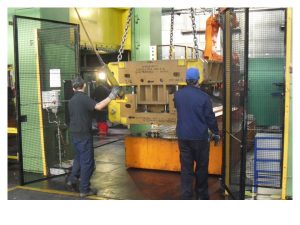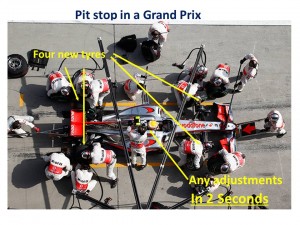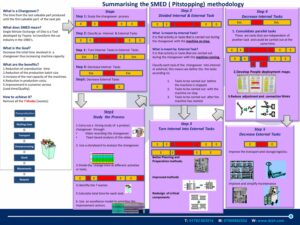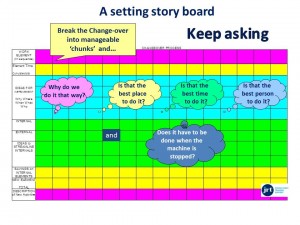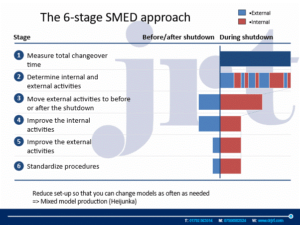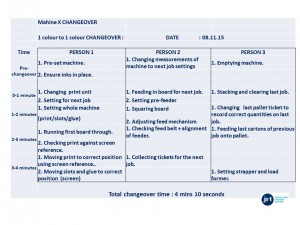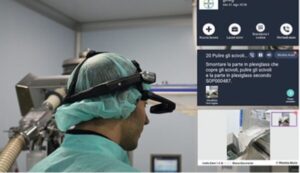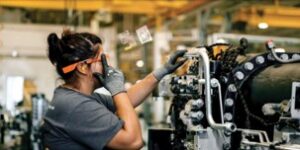..Profit from efficiency : Grand Prix Style S.M.E.D. Changeovers
Why is Changeover Performance so important to your business?
- The speed in meeting customer orders is becoming increasingly important.
- The companies who respond the fastest will win those orders.
- Over the years, order sizes in many industries have tended to reduce and as a consequence, machine changeovers become more frequent.
- The more time that is spent in product change-over : the less time we have for servicing those orders.
- No money is produced by a machine which is changing over.
- The more effective our changeovers : the better our service and profitability.
What is a Changeover?
It is the time from the production of the last saleable part to the production of first saleable part of the next job.
What does SMED mean
Single Minute Exchange of Dies.
This is a tool developed by Toyota to transform the car industry in the 1980s and is now used in a range of industries to reduce inefficiency.
We prefer to call it PITSTOPPING because people tend to understand the concept of a Grand Prix changeover in a more straightforward way.
What is the Goal?
To decrease the total time involved in a changeover, in order to increase machine capacity.
What are the benefits?
- Reduction in unproductive changeover time.
- Reduction of the production batch.
- Increase the real capacity of the machines.
- Reduction in production costs.
Here is a summary of the approach (click on the graphic to expand):
Click on the summary below for a taster of the course content.
How the course is structured :
UNIT 1
The Importance of Analysing Machine Changeovers.
The key theme of this module is that Customer Service is highly dependent on the effectiveness of Machine changeovers.
Elements we investigate during this initial training include …
1. How much are changeovers costing in terms of potential capacity loss?
2. The importance of analysing changeovers in a structured way.
3. The effective use of video analysis in analysing changeovers.
4. Identifying the tools and techniques that aid changeover.
5. The effective deployment of people in the changeover.
6. Developing changeover procedures.
7. How to manage Pitstopping initiatives.
The purpose of this session is to plant the seeds for the future.
The ideas outlined at this initial session need to be accepted by the team and a plan agreed for undertaking video analysis before the next planned session.
The course ends with a need to firm up the team’s commitment and to get an agreement that they will undertake a video analysis exercise.
UNIT 2
Video analysis of the target processes.
The team will be expected to undertake (with help) video analysis exercises of their own process changeovers.
The team are required to generate at least 3 separate videos of typical changeovers on their particular process before the next session.
It is critical that these recordings are done by the teams themselves and not by management or some third party. In this way they will begin to question why some practices are undertaken and start to see method inconsistencies between individuals and shifts.
This session will therefore concentrate on intense analysis of the videos with a view to developing an action plan in Unit 3.
Here is a summary of the methodology (click to expand):
UNIT 3
Generating a Pitstopping action plan.
The aims of this session is to re-enforce the concepts of Pitstopping taught in the earlier session and to encourage the team to use these concepts to come up with their own improvement ideas.
Elements we investigate include ..
1. Optimised layout techniques and methods.
2. Check sheets and SMART cards for recording settings.
3. Optimised fixing methods.
4. Kanban and POKA YOKE techniques.
5. People deployment maps.
6. Optimising people deployment.
7. Developing a prioritised action plan using Excellence models.
8. Agree outline targets for the project.
As such this session will consist of a combination of teaching and practical exercises focusing on the video analysis of the target process.
The ultimate aim is to develop a prioritised action plan for a significant reduction in changeover times by the end of the session.
Bringing Pitstopping into the world of Industry 4.0!
Extended Reality (XR) techniques.
XR incorporates, among other things, the related technologies of augmented reality (AR) and virtual reality (VR).
AR superimposes digital data on the real world, either through mobile devices like tablets or special head-mounted displays (HMDs).
VR uses HMDs to contain the user in a purely digital world.
Both technologies offer a thrilling glimpse into a future that blurs the line between the physical and digital worlds.
One other term is often used in the context of XR: mixed reality (MR).
Augmented Reality Systems for managing Changeovers:
AR transforms volumes of data and analytics into images or animations that are overlaid on the real world.
Today, most AR applications are delivered through mobile devices, but increasingly delivery will shift to hands-free wearables such as head-mounted displays or smart glasses.
The following photograph illustrates how augmented reality technology can be used to reduce changeover times when switching product lines.
Wearable AR devices for factory workers that superimpose production-assembly or service instructions are being piloted at thousands of companies. AR is supplementing or replacing traditional manuals and training methods at an ever-faster pace.
Traditional pages on flat screens—have a major limitation – they require people to mentally translate 2-D information for use in a 3-D world.
That isn’t always easy, as anyone who has used a manual to assemble flat-pack furniture knows.
By superimposing digital information directly on real objects or environments, AR allows people to process the physical and digital simultaneously, eliminating the need to mentally bridge the two.
That improves our ability to rapidly and accurately absorb information, make decisions, and execute required tasks quickly and efficiently.
Complicated 2-D schematic representations of a changeover procedure in a manual, for example, become interactive 3-D holograms that walk the user through the necessary changeover processes.
Little is left to the imagination or interpretation.
This is particularly relevant to managing Changeover practices.
Ongoing support
Follow up and Mentoring aimed at supporting and re-enforcing the initiative.
We can provide the appropriate level of ongoing support to the changeover reduction time project. This can take the form of :
1. Review of progress against action plan.
2. Evaluate changeover time reduction achieved.
3. Re-enforce key messages and techniques as appropriate.
4. Set targets for the next review.
